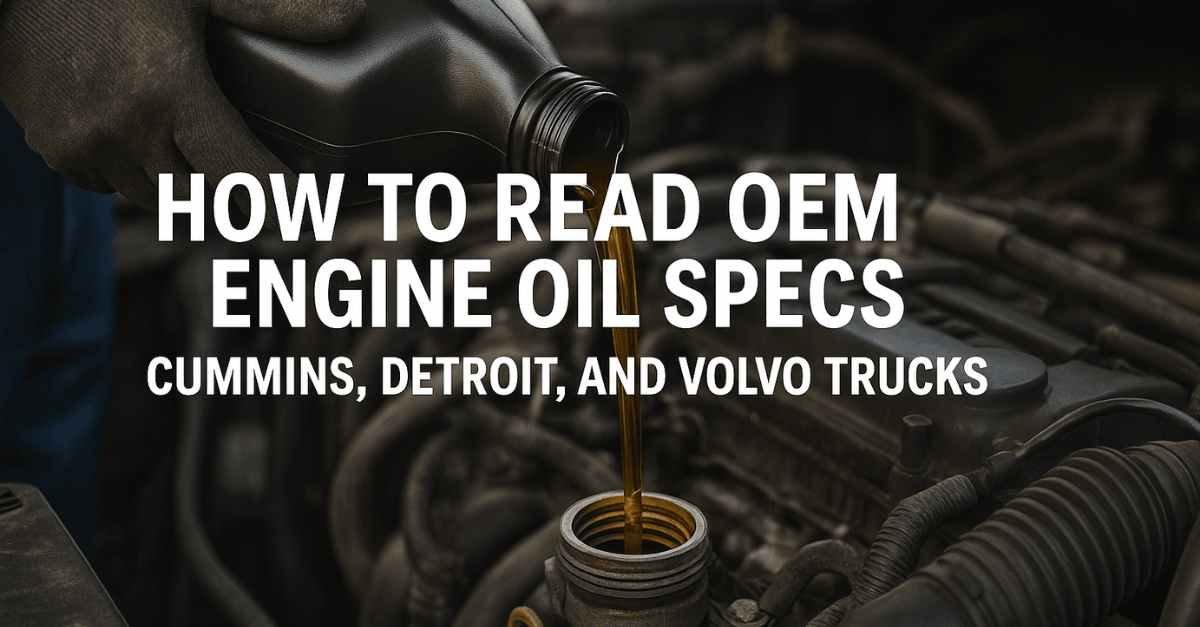
For fleet managers and technicians, properly interpreting OEM engine oil specifications is crucial to ensuring optimal performance and longevity of commercial truck engines. Each manufacturer has developed their own set of requirements, creating a complex landscape of specifications that can be challenging to navigate. This comprehensive guide breaks down how to read and understand engine oil specifications for three major truck engine manufacturers: Cummins, Detroit, and Volvo.
Before diving into manufacturer-specific details, it's important to understand the basic components of engine oil specifications:
Viscosity is perhaps the most recognizable specification, expressed as numbers like 15W-40 or 10W-30:
These typically include:
Cummins engines are widely used across North America and globally, with specifications that have evolved significantly over the years.
Cummins uses a system called CES (Cummins Engineering Standard) followed by a numerical designation. The most common specifications include:
When reading Cummins engine oil specs, pay special attention to:
For a 2022 Cummins X15 engine, specifications might read:
"Requires CES 20086, API CK-4 oil with maximum sulfated ash content of 1.0%, 10W-30 viscosity recommended for ambient temperatures between -15°F to 100°F."
Detroit Diesel (now Detroit) engines have their own unique set of requirements that have become increasingly stringent with newer emission systems.
Detroit uses the DFS system to classify their oil requirements:
When analyzing Detroit engine oil specifications, focus on:
For a 2023 Detroit DD15 engine, you might see:
"Requires DFS 93K224 approved oil, API CK-4 or FA-4 with 10W-30 viscosity. Maximum sulfated ash content 1.0%. Oil drain interval up to 50,000 miles with approved oils and engine monitoring."
Volvo Trucks uses its own designation system, often referencing both European and North American standards.
Volvo specifications include:
When interpreting Volvo engine oil specs, pay special attention to:
For a 2024 Volvo D13 engine, specifications might include:
"Requires Volvo VDS-5 approved oil, compatible with API FA-4, 10W-30 viscosity. Extended drain intervals of 60,000 miles available with approved oils and oil analysis program."
One of the most challenging aspects for technicians is finding oils that meet multiple OEM specifications. Here's how to approach this process:
Most modern heavy-duty engine oils will list their approvals directly on the packaging. Look for:
For mixed fleets, creating a cross-reference matrix can be invaluable:
| Engine Type | API Spec | OEM Spec | Preferred Viscosity | Ash Content |
|---|---|---|---|---|
| Cummins X15 (2021+) | CK-4 | CES 20086 | 10W-30 | 1.0% max |
| Detroit DD15 (2022+) | CK-4/FA-4 | DFS 93K224 | 10W-30 | 1.0% max |
| Volvo D13 (2023+) | FA-4 | VDS-5 | 10W-30 | 1.0% max |
Even experienced technicians can misinterpret specifications. Here are common pitfalls to avoid:
While API categories (like CK-4) provide a baseline, manufacturer-specific requirements often include additional parameters not covered by API.
Viscosity recommendations often vary by climate and operating conditions. Using a 15W-40 when a 5W-30 is recommended for cold climates can significantly impact engine protection.
Manufacturers occasionally update their requirements. Always check the most recent engine manual or manufacturer website for the latest specifications.
Some oils meeting basic specifications may not qualify for extended drain intervals, which often have additional requirements.
For maintenance professionals working across multiple engine types, here's a practical approach to ensuring specification compliance:
Keep a current reference guide with the latest specifications for all engines in your fleet.
Knowing why certain specifications exist (emissions compliance, component protection, etc.) helps in making informed decisions when exact specification matches aren't available.
Regular oil analysis provides direct feedback on oil performance and can help optimize drain intervals while ensuring engine protection.
For mixed fleets, finding oils that meet all relevant specifications can simplify inventory and reduce the risk of misapplication.
Understanding and correctly applying OEM engine oil specifications is a critical aspect of fleet maintenance. While the landscape of specifications from Cummins, Detroit, and Volvo may seem complex, a methodical approach to interpreting these requirements can lead to optimal engine protection, maximum service intervals, and lower total operating costs.
For fleets seeking to optimize their maintenance programs and ensure specification compliance across their equipment, comprehensive maintenance solutions can make a significant difference. At FleetRabbit, we specialize in helping fleet managers navigate these complex specifications and implement maintenance programs that ensure compliance while maximizing uptime.
Visit FleetRabbit.com to learn more about how our maintenance solutions can help your fleet achieve optimal performance while meeting all manufacturer specifications.